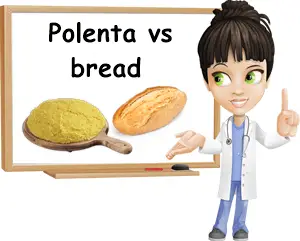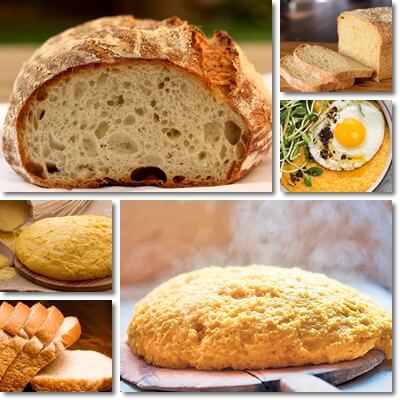There is an ongoing debate about whether or not eating polenta is better for your health than eating bread. However, when it comes to choosing which is healthier, polenta or bread, know there are many variables that you should take into account before deciding if either one is good for you or not. The most important of that variables is your health with existing medical issues as reference. So your health at this point is what determines the foods you can and cannot eat and in what amounts and whether polenta and bread are good or bad for you.
Here are some examples of how an existing medical condition impacts your dietary choices. For example, a person with celiac disease should avoid foods that contain gluten. That person can eat polenta made from cornflour (maize flour), which is not the same thing as cornstarch, a starch extracted from corn and used for thickening dishes or making corn syrup. But that person shouldn’t eat wheat, oats, rye, barley and the breads made from them because they contain gluten.

A person with hyperglycemia or diabetes should avoid foods with a high glycemic index because they raise blood sugar levels too much too fast. This would mean they shouldn’t eat bread because it has a high glycemic index. But polenta might be a good choice: despite cornflour (again, not the same thing as cornstarch) having a moderate glycemic index, polenta will have a moderately low glycemic load because it will contain far less carbohydrates per actual serving than cornflour so it will not raise blood sugar levels that much.
At the same time, if you are a long-distance runner but otherwise healthy, then eating foods with a high glycemic index will help sustain the physical effort, so bread, pasta and other products made from wheat are a good option if you are training preparing for a marathon. In other words, deciding between polenta vs bread is difficult because of the many variables involved. What you can and should do is analyze the two foods and their nutritional profile to better understand how they can impact your health. Find out below how to tell which of the two is healthier for you.
Nutrition and health effects
1) Polenta and bread glycemic index and glycemic load. What is glycemic index and what is glycemic load? Glycemic index is a number measuring how fast and how much different foods you eat raise your blood sugar levels. Values are compared against refined sugar which has a maximum glycemic index of 100. Glycemic load measures how much a single serving of a certain food can raise blood sugar levels. The two measurements are used to help people with diabetes or hyperglycemia choose what foods to eat and what foods to avoid. Also, the two measurements can vary for the same food.
Glycemic index is measured as follows:
Low: 0-50/55
Moderate: 50/55-70
High: 70-100
Glycemic load is calculated with the following formula:
g of carbs in a serving X glycemic index of a certain food : 100
Low: 0-10 glycemic load per serving
Moderate: 11-19
High: over 20

Polenta is made from cornflour, maize flour or cornmeal (not the same thing as corn starch). Cornflour glycemic index is about 68, which is moderately high. But a serving of 100 g of polenta has around 15 g of carbohydrate, which translated into a moderate glycemic load of 10.2. White bread has a 72 glycemic index value, which is relatively high. 100 g contains about 50 g of carbohydrates, which means white bread has a 36 glycemic load value. But since the recommended amount of commercial white bread is about 30 g, one serving will have a moderately low glycemic load of 12.
Technically, if you eat only 100 g of polenta or only 30 g of bread in a day, neither will raise blood sugar levels very much. However, the reason why they are problematic foods for diabetes and hyperglycemia sufferers and those looking to lose weight is because you don’t eat only 30 g of bread or a serving of polenta a day and get other carbohydrates from other foods too. So despite having good numbers, they might be best eaten in moderation.
2) Polenta vs bread gluten content. Things are simple here: polenta does not contain gluten and is safe to eat if you have celiac disease or gluten sensitivity (read more about its benefits here). Bread made from or with wheat, rye, oats or barley has gluten and can be bad for anyone with difficulty digestion gluten. Other gluten-free flours include rice, amaranth, buckwheat, potato, bean and nut flours.
3) Polenta and bread calories per 100 g. The average person is estimated to fare well on a 2,000 kcal diet. Bread products are typically high in calories, while polenta has a moderate energetic value. In this respect, it would appear that polenta is a better choice than bread in terms of energetic value.
– White bread: 265 kcal/ 100 g
– Whole wheat bread: 258 kcal/100 g
– Rye bread: 259 kcal/100 g
– Potato flour bread: 266 kcal/100 g
– Polenta, boiled or baked, simple recipe: 70 kcal/100 g
– Polenta with added butter, cheese or other ingredients can have up to 350 kcal/100 g or more.
4) Bread vs polenta nutritional facts.Typically, the following values may apply:
– Polenta nutrition facts per 100 g: 15 g of carbohydrates, 2 g of protein, no fat, good amounts of sodium and vitamin A and small amounts of B vitamins. It also contains small amounts of vitamin C (12% of the RDI), but cooking heat destroys it completely.
– Commercial white bread nutrition facts per 100 g: 44-50 g of carbohydrates, 5 g of sugar, 9-11 g of protein, 2-3 g of fat, high in sodium and calcium, contains good amounts of B vitamins (25 to 30% of the RDI of niacin, almost 50% of the RDI of thiamine, about 20% riboflavin, 160-170 mcg of folate out of the recommended 400 mcg), 3.6-4.8 mg of iron out of the RDI of 18 mg as well as small amounts of magnesium, phosphorus and zinc.
Whole grain bread or bread made with enriched flour as well as polenta made with enriched cornmeal all have superior nutritional values. Overall, it would appear bread is better than polenta from a nutritional point of view. At the same time, it contains gluten which is bad for those suffering from celiac disease and gluten sensitivity. Also, most people will eat more than 30 g of bread a day which means a high glycemic load after all and high blood sugar levels which, in time, could increase the risk of diabetes, weight gain, hypertension and other diseases.
Conclusion
If you will ever read in magazines or online articles that polenta is always a better choice than bread, know that this is just a superficial deduction. Many people are so quick to blame anything processed that they forget all foods are a double-sided coin: they have both benefits and side effects and affect people and their health differently. Because not everyone reacts the same way to the same food. I’m not saying eating white bread is good for you, but going all the way polenta may not be the solution either. The smart thing to do is to first consider your health and any existing medical conditions. Then analyze foods like bread and polenta and see what nutrients they contain and how those nutrients affect you individually. Only then can you say for sure which is healthier for you, polenta or bread.
